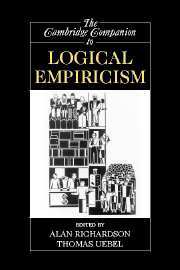Book contents
- Frontmatter
- Introduction
- Part I The Historical Context of Logical Empiricism
- 1 The Vienna Circle: Context, Profile, and Development
- 2 The Society for Empirical/Scientific Philosophy
- 3 From “the Life of the Present” to the “Icy Slopes of Logic”: Logical Empiricism, the Unity of Science Movement, and the Cold War
- Part II Logical Empiricism: Issues in General Philosophy of Science
- Part III Logical Empiricism and the Philosophy of the Special Sciences
- Part IV Logical Empiricism and its Critics
- Bibliography
- Index
- Series List
1 - The Vienna Circle: Context, Profile, and Development
from Part I - The Historical Context of Logical Empiricism
Published online by Cambridge University Press: 28 January 2008
- Frontmatter
- Introduction
- Part I The Historical Context of Logical Empiricism
- 1 The Vienna Circle: Context, Profile, and Development
- 2 The Society for Empirical/Scientific Philosophy
- 3 From “the Life of the Present” to the “Icy Slopes of Logic”: Logical Empiricism, the Unity of Science Movement, and the Cold War
- Part II Logical Empiricism: Issues in General Philosophy of Science
- Part III Logical Empiricism and the Philosophy of the Special Sciences
- Part IV Logical Empiricism and its Critics
- Bibliography
- Index
- Series List
Summary
INTRODUCTION. THE COLLECTIVE DIMENSION: EMERGENCE AND DEVELOPMENT OF THE VIENNA CIRCLE
The so-called Vienna Circle of logical empiricism first came to public attention in 1929 with the publication of a manifesto entitled Wissenschaftliche Weltauffassung. Der Wiener Kreis (The Scientific World-Conception. The Vienna Circle). Published for the Ernst Mach Society, this influential philosophical manifesto - dedicated to Moritz Schlick, the titular leader of the Vienna Circle - was signed by Rudolf Carnap, Hans Hahn, and Otto Neurath, who may be regarded as its editors and, with Herbert Feigl, its authors (Mulder 1968). The name “Vienna Circle” was originally suggested by Otto Neurath, who wanted to evoke pleasant associations with the “Vienna woods” or the “Viennese waltz” by alluding to the local origin of this collective (Frank 1949, 38).
The plan for this publication was set in motion when Moritz Schlick, who had come to Vienna in 1922 to take up a professorial appointment previously held by Ernst Mach and Ludwig Boltzmann (and Adolf Stöhr) and had founded the Vienna Circle in 1924, received a lucrative offer from the University of Bonn at the beginning of 1929. The threatened departure of Schlick was to be prevented by a joint official declaration of solidarity by the members of the Vienna Circle, the Ernst Mach Society (of which he was the head from 1928 to 1934), and further sympathizers with the cause of scientific philosophy.
- Type
- Chapter
- Information
- The Cambridge Companion to Logical Empiricism , pp. 13 - 40Publisher: Cambridge University PressPrint publication year: 2007
- 14
- Cited by



